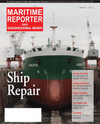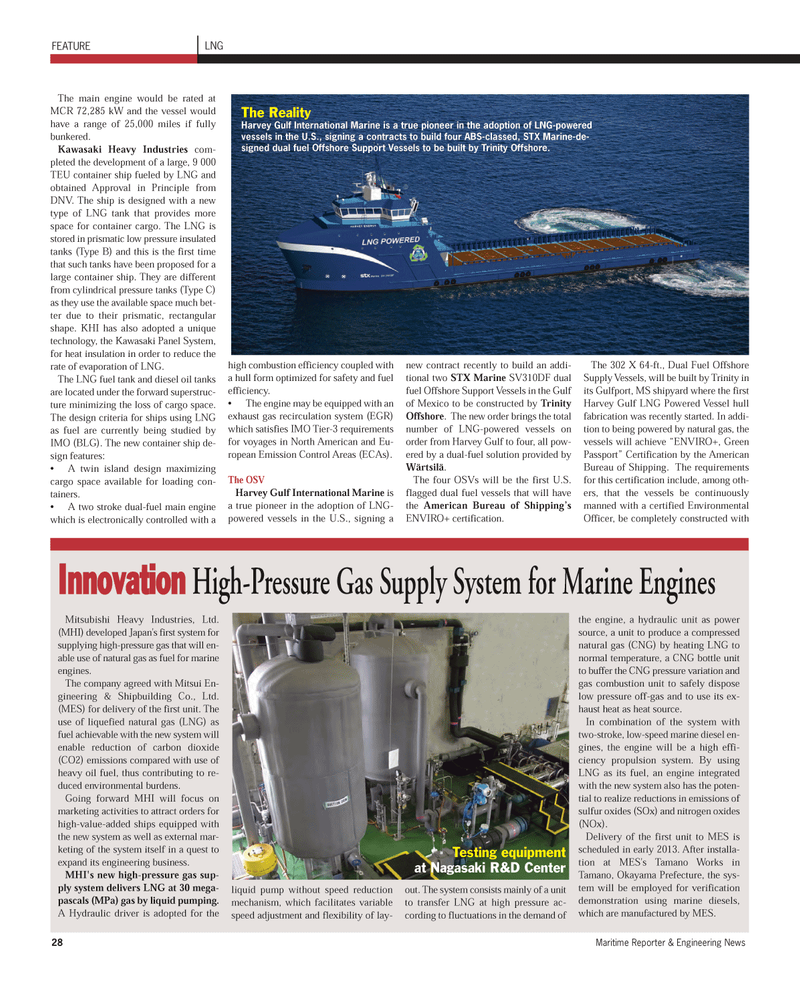
Page 28: of Maritime Reporter Magazine (March 2012)
The Ship Repair Edition
Read this page in Pdf, Flash or Html5 edition of March 2012 Maritime Reporter Magazine
Mitsubishi Heavy Industries, Ltd. (MHI) developed Japan's first system for supplying high-pressure gas that will en- able use of natural gas as fuel for marine engines. The company agreed with Mitsui En- gineering & Shipbuilding Co., Ltd. (MES) for delivery of the first unit. The use of liquefied natural gas (LNG) as fuel achievable with the new system will enable reduction of carbon dioxide(CO2) emissions compared with use ofheavy oil fuel, thus contributing to re- duced environmental burdens. Going forward MHI will focus on marketing activities to attract orders for high-value-added ships equipped with the new system as well as external mar- keting of the system itself in a quest to expand its engineering business. MHI's new high-pressure gas sup- ply system delivers LNG at 30 mega- pascals (MPa) gas by liquid pumping. AHydraulic driver is adopted for the liquid pump without speed reductionmechanism, which facilitates variable speed adjustment and flexibility of lay- out. The system consists mainly of a unit to transfer LNG at high pressure ac-cording to fluctuations in the demand ofthe engine, a hydraulic unit as power source, a unit to produce a compressednatural gas (CNG) by heating LNG to normal temperature, a CNG bottle unitto buffer the CNG pressure variation and gas combustion unit to safely dispose low pressure off-gas and to use its ex- haust heat as heat source. In combination of the system withtwo-stroke, low-speed marine diesel en- gines, the engine will be a high effi- ciency propulsion system. By using LNG as its fuel, an engine integrated with the new system also has the poten- tial to realize reductions in emissions ofsulfur oxides (SOx) and nitrogen oxides(NOx). Delivery of the first unit to MES is scheduled in early 2013. After installa- tion at MES's Tamano Works in Tamano, Okayama Prefecture, the sys- tem will be employed for verification demonstration using marine diesels,which are manufactured by MES. 28Maritime Reporter & Engineering News FEATURE LNGInnovationHigh-Pressure Gas Supply System for Marine Engines Testing equipment at Nagasaki R&D CenterThe main engine would be rated at MCR 72,285 kW and the vessel would have a range of 25,000 miles if fully bunkered. Kawasaki Heavy Industries com-pleted the development of a large, 9 000 TEU container ship fueled by LNG andobtained Approval in Principle from DNV. The ship is designed with a new type of LNG tank that provides more space for container cargo. The LNG is stored in prismatic low pressure insulated tanks (Type B) and this is the first time that such tanks have been proposed for a large container ship. They are different from cylindrical pressure tanks (Type C) as they use the available space much bet- ter due to their prismatic, rectangularshape. KHI has also adopted a uniquetechnology, the Kawasaki Panel System, for heat insulation in order to reduce therate of evaporation of LNG. The LNG fuel tank and diesel oil tanksare located under the forward superstruc- ture minimizing the loss of cargo space. The design criteria for ships using LNGas fuel are currently being studied byIMO (BLG). The new container ship de- sign features: A twin island design maximizing cargo space available for loading con- tainers. A two stroke dual-fuel main engine which is electronically controlled with ahigh combustion efficiency coupled with a hull form optimized for safety and fuelefficiency. The engine may be equipped with an exhaust gas recirculation system (EGR) which satisfies IMO Tier-3 requirements for voyages in North American and Eu- ropean Emission Control Areas (ECAs). The OSVHarvey Gulf International Marine isa true pioneer in the adoption of LNG-powered vessels in the U.S., signing a new contract recently to build an addi- tional two STX MarineSV310DF dualfuel Offshore Support Vessels in the Gulf of Mexico to be constructed by Trinity Offshore . The new order brings the total number of LNG-powered vessels on order from Harvey Gulf to four, all pow- ered by a dual-fuel solution provided by Wärtsilä.The four OSVs will be the first U.S. flagged dual fuel vessels that will have the American Bureau of Shipping?s ENVIRO+ certification. The 302 X 64-ft., Dual Fuel Offshore Supply Vessels, will be built by Trinity in its Gulfport, MS shipyard where the first Harvey Gulf LNG Powered Vessel hull fabrication was recently started. In addi- tion to being powered by natural gas, the vessels will achieve ?ENVIRO+, Green Passport? Certification by the American Bureau of Shipping. The requirements for this certification include, among oth- ers, that the vessels be continuously manned with a certified Environmental Officer, be completely constructed with The RealityHarvey Gulf International Marine is a true pioneer in the adoption of LNG-powered vessels in the U.S., signing a contracts to build four ABS-classed, STX Marine-de-signed dual fuel Offshore Support Vessels to be built by Trinity Offshore. MR March 12 # 4 (25-32):MR Template 3/6/2012 4:18 PM Page 28

 27
27

 29
29
